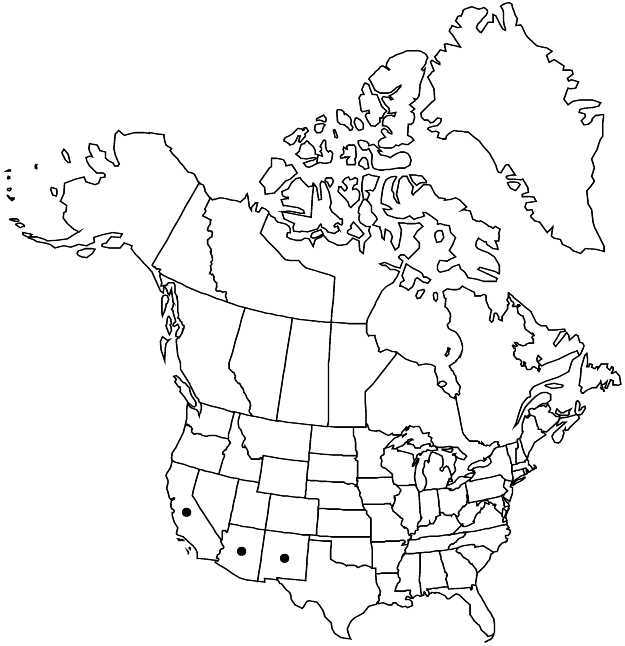Difference between revisions of "Eriogonum thurberi"
in W. H. Emory, Rep. U.S. Mex. Bound. 2(1): 176. 1859.
FNA>Volume Importer |
FNA>Volume Importer |
||
| Line 12: | Line 12: | ||
|name=Eriogonum cernuum subsp. thurberi | |name=Eriogonum cernuum subsp. thurberi | ||
|authority=(Torrey) S. Stokes | |authority=(Torrey) S. Stokes | ||
| + | |rank=subspecies | ||
}} {{Treatment/ID/Synonym | }} {{Treatment/ID/Synonym | ||
|name=Eriogonum cernuum subsp. viscosum | |name=Eriogonum cernuum subsp. viscosum | ||
|authority=S. Stokes | |authority=S. Stokes | ||
| + | |rank=subspecies | ||
}} | }} | ||
|hierarchy=Polygonaceae;Polygonaceae subfam. Eriogonoideae;Eriogonum;Eriogonum subg. Ganysma;Eriogonum thurberi | |hierarchy=Polygonaceae;Polygonaceae subfam. Eriogonoideae;Eriogonum;Eriogonum subg. Ganysma;Eriogonum thurberi | ||
| Line 39: | Line 41: | ||
-->{{#Taxon: | -->{{#Taxon: | ||
name=Eriogonum thurberi | name=Eriogonum thurberi | ||
| − | |||
|authority=Torrey in W. H. Emory | |authority=Torrey in W. H. Emory | ||
|rank=species | |rank=species | ||
| Line 54: | Line 55: | ||
|publication year=1859 | |publication year=1859 | ||
|special status= | |special status= | ||
| − | |source xml=https://jpend@bitbucket.org/aafc-mbb/fna-data-curation.git/src/ | + | |source xml=https://jpend@bitbucket.org/aafc-mbb/fna-data-curation.git/src/f50eec43f223ca0e34566be0b046453a0960e173/coarse_grained_fna_xml/V5/V5_834.xml |
|subfamily=Polygonaceae subfam. Eriogonoideae | |subfamily=Polygonaceae subfam. Eriogonoideae | ||
|genus=Eriogonum | |genus=Eriogonum | ||
Revision as of 22:57, 16 December 2019
Herbs, spreading, annual, 0.5–4 dm, glabrate, glabrous or sparsely glandular, greenish, grayish, or reddish. Stems: caudex absent; aerial flowering stems erect, solid, not fistulose, 0.3–1 dm, often sparsely tomentose and glandular proximally. Leaves basal; petiole 1–3 cm; blade oblong to narrowly ovate, 0.8–4.5 × 0.5–3 cm, densely white-tomentose abaxially, floccose or glabrous and greenish adaxially, margins often crenulate. Inflorescences cymose, mostly diffuse, 5–30 × 5–50 cm; branches sparsely glandular to glabrate or glabrous; bracts 3, scalelike, 1–2.5 × 1–2.5 mm. Peduncles erect, straight, capillary, 0.5–2.5 cm, glabrous and glandular-puberulent distally. Involucres broadly turbinate, 1.8–2 × 1.8–2 mm, minutely glandular-puberulent; teeth 5, erect, 0.4–0.6 mm. Flowers 1–1.7 mm; perianth white with greenish or reddish midribs, becoming red, glandular-puberulent with a tuft of long white hairs adaxially; tepals dimorphic, those of outer whorl broadly pandurate or flabellate, those of inner whorl oblanceolate; stamens included, 0.7–1.2 mm; filaments mostly glabrous. Achenes brown to black, usually lenticular, 0.6–0.8 mm, glabrous. 2n = 40.
Phenology: Flowering year-round.
Habitat: Sandy flats, washes, and slopes, saltbush, greasewood, and creosote bush communities, oak, pinyon and/or juniper woodlands, (montane conifer woodlands in Mexico)
Elevation: 100-1200 m
Distribution

Ariz., Calif., N.Mex., Mexico (Baja California, Sonora).
Discussion
Eriogonum thurberi is common to abundant but rarely weedy in northwestern Mexico, southern California (Inyo, Los Angeles, Orange, Riverside, San Bernardino, and San Diego counties), and southern Arizona (Cochise, Gila, Graham, Maricopa, Mohave, Pima, Pinal, Santa Cruz, and Yavapai counties). It just enters New Mexico (Grant County). It and E. thomasii are the annual members of the E. cernuum complex typically found on the Mojave and Sonoran deserts, with E. thurberi extending farther to the east and E. thomasii farther to the north. The two occasionally grow together.
Selected References
None.